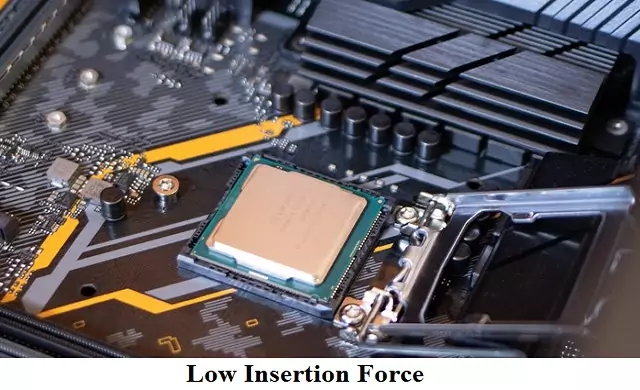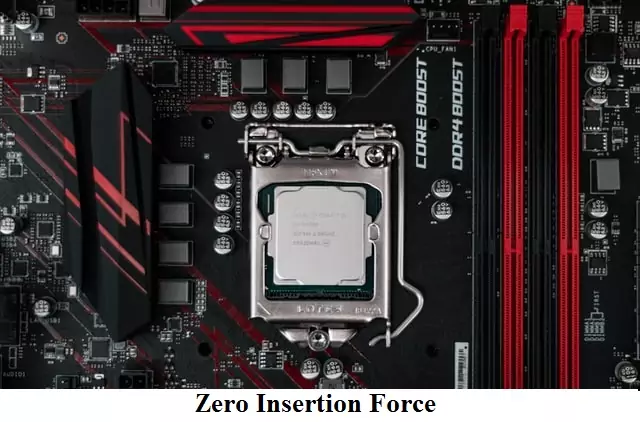
What is Processor (CPU) in Computer:
Definition:
The processor is an IC (Integrated Circuit). It takes input from user, store in the memory, process it and desired output to the user.
Characteristics:
• It is also known as a computer brain or CPU (Central Processing Unit).
• Clock speed of a processor 66 MHz to 3.86 MHz
What is Processor Packaging:
The process of attaching with a motherboard is called as Processor Packaging.
Types of Processor Packaging:
• PGA:
Its full from Pin Grid Array. A PGA is a type of integrated circuit processor packaging. In PGA, pins are situated in the processor while the socket on the motherboard contains holes to attach the CPU. It is commonly used by Intel. This type of setup uses a pressure lever to hold the CPU in the motherboard.
Example – PGA 370, PGA 484, PGA 478, PGA 754.

• LGA:
Its full from Land Grid Array. An LGA is a type of integrated circuit processor packaging. In LGA, pins are situated in the socket on the motherboard and processor is dot surface. It is used to hold the CPU on the motherboard.
Example – LGA 775, LGA 1155, LGA 1156, LGA 1366, LGA 1248.

Processor Installation:
There are 2 types of processor installation –
• LIF:
Its full from Low Insertion Force. LIF is a type of CPU socket on a computer motherboard that allows to simple replace the processor (zero force) and here does not contain any lever like ZIF socket to remove the processor. It is used in LGA processor.

• ZIF:
Its full from Zero Insertion Force. It was designed by Intel and here a small lever to insert for remove the computer processor. It is used in PGA processors.

Intel Processor Series:
• 8085
• 8086
• 8088
• 80286
• 80386
• 80486
• Pentium – 1
• Pentium – 2
• Pentium – 3
• Pentium – 4
• Celeron
• Atom (Smallest Processor)
• Xeon
• Duel Core
• Core – 2 Duel
• Quad Core
• i-3
• i-5
• i-7
• i-9
Types of Processor:
• CISC:
Its full from Complex Instruction Set Computer. It is developed by Intel for a computer in which single instructions can execute several low-level operations.
• RISC:
Its full from Reduced Instruction Set Computer. It is a microprocessor that is designed to perform a smaller number of computer instructions so, that it can operate of a higher speed.
Computer Processor Interview Interview Questions:
Q. What is Microprocessor?
Ans: – The microprocessor is a program-controlled device that reads a set of steps to be executed from memory.
Q. What is Multitasking?
Ans: – The ability to execute more than one task at the same time, a task being a program, is called as Multitasking. Multitasking is the use of two or more CPU (Central Processing unit) within a single computer system.
Q. What is Hyperthreading?
Ans: – Hyperthreading is a technology developed by Intel. Hyperthreading enables a single physical processor to work as logically 2 processor. It was launched with Pentium – 4 processor.
Q. What is Nehalem Architecture?
Ans: – Nehalem is the codename for Intel processor microarchitecture, it was released in November, 2008. Nehalem was used in the First Generation of the Intel core processor (i-3, i-5, i-7, i-9).
Q. What is full from of AMD?
Ans: – Advanced Micro device.
Q. Name of some processor manufacturer company?
Ans: – Intel, AMD, IBM, Hitachi, Nvidia, Samsung.
Q. What is the latest processor of Intel?
Ans: – Core i-9.
Q. What is the latest processor of AMD?
Ans: – AMD Ryzen.
Q. How to buy a Processor?
Ans:-
• Clock Speed
• Series
• Manufacturer Company
• L2/ Cache
• USB Speed
Q. How many Physical cores are there in Intel cores i-3, i-5, i-7, i-9?
Ans: –
• i-3 :- 2 Physical Cores
• i-5 :- 2 or 4 Physical Cores
• i-7 :- 4 Physical Cores
• i-9 :- 10 – 18 Physical Cores
Q. Different between PGA & LGA?
Ans: –
| PGA | LGA |
|---|---|
| Its full from Pin Grid Array. | Its full from Land Grid Array. |
| Here pins are situated on the CPU while the socket on the motherboard contains whole the attach CPU. | Here pins are situated on the CPU socket on the motherboard while CPU is dot surface. |
| PGA socket can be referred to as the Zero Insertion Force (ZIF) Socket. | LGA Socket can be referred to uses a pressure lever to hold the CPU in place. |
| It is commonly used by AMD. | It is commonly used by Intel. |
Q. Different between CISC & RISC?
Ans: –
| CISC | RISC |
|---|---|
| Its full from Complex Instruction Set Computer. | Its full from reduced Instruction Set Computer. |
| It is designed for single instruction can execute several low-level operations. | It is designed to perform a smaller number of computer instructions so, that it can be operated at a higher speed. |
| It is a large and complex set of instructions. | It is a small and highly optimized set of instructions. |
| It is mainly used in Hardware Control units, like mobile phones and tablets. | It is mainly used in Microprogrammed Control Unit, like desktop computers and laptops. |
Q. Which is the suitable processor for server & Workstation system?
Ans: – Intel Xeon.
Q. What is the cause of overheating of the Microprocessor?
Ans: –
• Processor fan may not be properly connected.
• Heat Sink maybe not be connected properly with the processor.
• Jumper may be configured to overclock the CPU.
• Voltage supply incompatibility.
Q. What are factors the speed of the microprocessor?
Ans: – The CPU’s FSB speed determines the maximum speed at which it can transfer data to the rest of the system.
Q. What is the difference between Processor & Microprocessor?
Ans: – The Central Processor Unit (CPU) or Processor is a chip that work as a brain of the computer system. But Microprocessor is more than the CPU. It contains other processor, like the Graphics processor unit, Sound Card and Network Cards are control by Microprocessor. So, a CPU is a part of a microprocessor but a Microprocessor is more than the CPU.
Q. What are the differences between Celeron and Pentium?
Ans: –
| Celeron | Pentium |
|---|---|
| In Celeron multiprocessing is not supported. | In Pentium multiprocessing in supported. |
| In Celeron Hyper-threading is not supported. | Hyper-threading is supported in Pentium. |
| Celeron chips are cheaper than Pentium chips. | Pentium chips are relatively pricier than Celeron. |
Q. What are the differences between Pentium3 and Pintium4?
Ans: –
| Pentium3 | Pentium3 |
|---|---|
| In a Pentium processor, the bus speed is generally 133MHZ. | The low speed is Pentium4 bus speed 400MHZ and highest 1006MHZ. |
| Pentium3 high of cache 512KB. | Pentium4 is smaller than Pentium3 and Pentium lowers cache memory by 512KB. |
Q. What is overclocking? What are the advantages of overclocking?
Ans: – It is a process where the computer component is forced to run at a higher clock rate. The advantages of overclocking are as below,
• Increases the CPU’s performance.
• It is cost-saving.
• Makes pc games and applications to run faster.
Q. What are the specifications of the processor?
Ans: –
• Make – Manufacturer Company, example – Intel or AMD
• Clock Speed – In Gigahertz (GHz)
• Cache Size – In MB
• FSB – In Megahertz (MHz)
Q. What is the bus speed?
Ans: – The rate of communication speed between microprocessor and RAM is known as bus speed.
Also Read: –
• Top 160 Networking Interview Questions & Answers
• Top 115 CCNA Interview Questions & Answers
• Top 60 Linux System Administrator Interview Questions
• Top 50 Linux Interview Questions & Answers
• Computer basic Troubleshooting Interview Questions with Answers
• Computer Hardware MCQ Questions & Answers
• Computer Network MCQ Questions & Answers
• Network-Devices-Hub-Repeater-Bridge-Switch-Router-Gateways
• Computer-network-transmission-mode
• Describe straight-through and a cross-over cable
• What is Transmission Media & Types of Transmission Media
• Types of Computer Network
• What is Operating System
• Network Topology
• Describe OSI model
• Describe TCP IP model
• What is BIOS
• What is Hard Disk
• RAM (Random Access Memory) definition
• CMOS Definition
• Basic Parts of a Computer
• Motherboard Definition Types Components Ports
• Components of switched-mode power supply
• Components of computer system
• Computer Input-Output Devices
• Different between Intel i-series processor Generation
• Microsoft Windows History
—O—